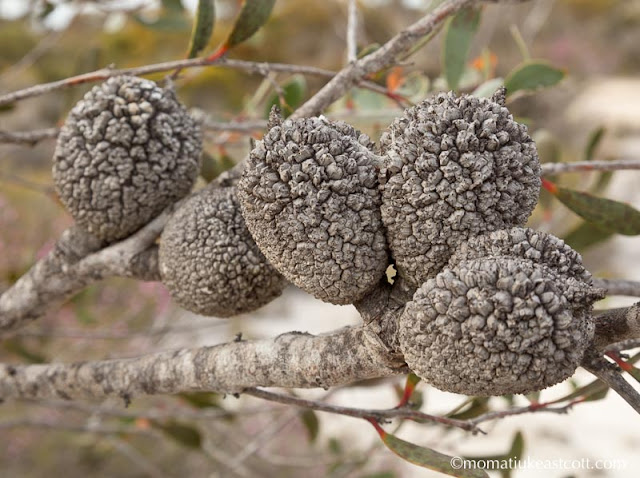But we linger for a few daybreaks and look for ice crystals painting their cold magic around dark boulders in mid-steam and breath-stopping white lace lining the banks. There are a few, and we descend on them hungrily. John mounts his tilt-equipped camera on a tripod, while I, always reluctant to lug around any heavy equipment, rely on my steady hand and the workhorse lens I like best. This means getting close, bending over the icy objects of my desire, and not breathing while pressing the shutter.
It also means scrambling over slippery and badly anchored boulders until it happens: a small dark rock rolls under my left foot, my balance goes all to hell, and I fall like a sack of something stupid with no control. My left femur bone screams: noooooo! and keeps screaming while trying to outdo my screaming calf abrasions.
I lie back on the rolling wet rocks with my feet touching the creek ice and breathe. Did I fracture something again? John fetches some ice, saying apologetically: "It is so thin it may not work" but I hold the ice right over my femur where the screams come from. The cold melt drips down my leg and it feels good. "You want to go back to the camper?" he asks but I stagger upright and tell him idiotically that just like riders who fell off their horses I am getting back in the saddle. I return to my ice crystals but by early evening my left knee refuses to bend and a huge hard swelling pops out just above my kneecap and laughs.
Wonderful. How may times have I done exactly that? Walked around so absorbed in my search of subjects I failed to watch for stuff which could -- and did -- trip me up? I swallow a bunch of Advil, promise myself to stay out of slimy rocks, briefly admire my audacity of attempting to fool myself with this promise, and fall into a nasty pain-studded slumber.
Next morning a fanciful mare's tail of a cirrus beckons and I am back on Dana Creek.
 There is all of it at once: brilliant crystal bridges, dark and gurgling water holes, spiky ice daggers, gently rounded corners and other fine details. But a few loud cracks of rapidly warming crystals tell me to back off, and this time I am paying attention.
There is all of it at once: brilliant crystal bridges, dark and gurgling water holes, spiky ice daggers, gently rounded corners and other fine details. But a few loud cracks of rapidly warming crystals tell me to back off, and this time I am paying attention.And then we drive down Tioga Road, skirt the Sierras and climb steep coastal hills of Southern California to find Benji. A climber and a sailor who teaches courses for National Outdoor School of Leadership, he was just hired as a tree specialist to help a nonprofit to restore its land ravaged by a massive wildfire two years ago. The Thomas Fire, one of California's worst, fueled by dry vegetation and hot Santa Ana winds, raged across almost 300,000 acres of hills and valleys in December 2017 and charred much along its path, including the Ojai Foundation. Well known for its programs helping people who seek "ways to deepen relationship with self, each other, and the natural world" the nonprofit lost 24 structures and its 36 acres were covered with charred debris.
No longer. Benji takes us around and we see nature triumphant: the tall feathery grasses are up, the flowers are blooming, and massive branches of California's live oaks are flexing their woody muscles. Small aloe plants look happy, too, and so do rambunctious trees walking along the ridge.
All we may need is love but some bread would be nice, too... and, like other alternative communities, Ojai has a few bakers who believe that flour, yeast, water and salt produce wonder loaves. All that other stuff, notoriously used to make what we call "imitation bread" or "toilet paper" we see across the country, is bordering on offensive. We buy a sackful of crusty fragrant loaves -- for us and for friends we will see soon -- and Benji and John use a couple as their evening bread faces.

The night arrives, with Great horned owls nailing it to every star. And soon the sun is scrambling through the ground fog again, licking the charred trunks already festooned with new leaves and tall grasses turning bright in the pale light.

©Yva Momatiuk










